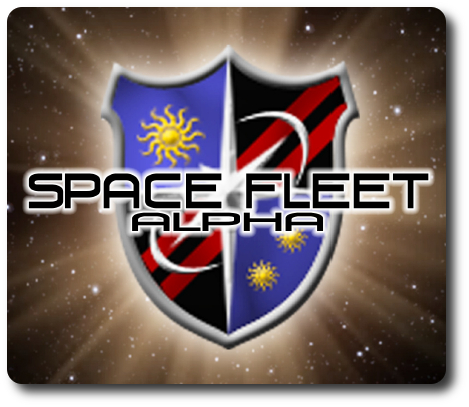
The Basics:
- For ages 8 and up (publisher suggests 12+)
- For 2 to 6 players
- Approximately 30 minutes to complete
Geek Skills:
- Active Listening & Communication
- Counting & Math
- Logical & Critical Decision Making
- Reading
- Strategy & Tactics
- Risk vs. Reward
- Hand/Resource Management
- Area Control
- Bluffing and Misdirection
Learning Curve:
- Child – Moderate
- Adult – Easy
Theme & Narrative:
- Wage war against other empires as each attempts to capture and control the emptiness of space
Endorsements:
- Gamer Geek approved!
- Parent Geek approved!
- Child Geek approved!
Overview
Space. Infinitely vast, cold, and deadly. The few planets that are inhabitable float in an endless empty void. Peace is only found between the dark spaces where nothing stirs. For when two or more intergalactic warships encounter each other in the dark starlit nothingness, where once there was only silence is now the violence of war and the horror of death. Ready your warship, Admiral. It’s time to earn your commission.
Space Fleet Alpha (2nd edition), by Gravity Games, is a comprised of Ship cards (representing battleships, cruisers, destroyers, gunships, and fighters), Faction cards (representing 6 different empires), and Bonus cards (representing special weapons, technology, and espionage tactics) for a total of 160 cards. Excellent artwork on the cards and minimal icon usage makes this card game not only easy to look at, but also easy to play.
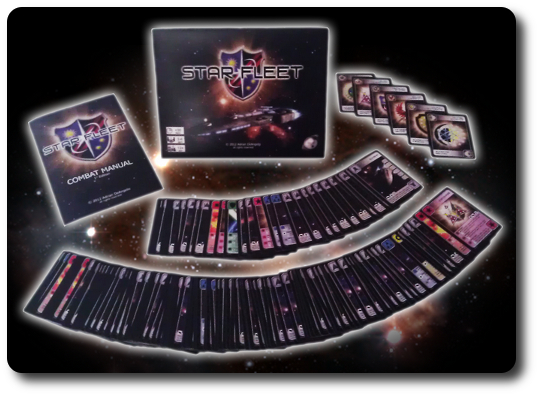
Game Set Up
To set up the game, first remove the 6 Faction cards, the 6 Race Technology cards, and the 6 Espionage cards. Then organize the cards into empires that have 3 cards each (1 Faction, 1 Race Technology, and 1 Espionage card that all share the same empire symbol). Have players select which empire they want to represent, taking all three cards that belong to that empire. Any empires not selected are removed for the duration of the game (all three cards).
Second, take the Espionage cards from all the players and shuffle them into the deck with the other cards. Shuffle this deck thoroughly. While the deck is being shuffled, each player should place their empire Faction and Race Technology cards in front of them, face-up. The space where these cards are placed is referred to as the player’s “strategic zone”.
Third, deal out 15 to 21 cards to each player. The number you decide to deal out only determines each player’s starting hand. For a more complicated game, deal out less cards. If a player isn’t dealt any Ship or Bonus cards, they can request a re-deal. In which case, their cards are reshuffled into the deck and a new hand is dealt; however, 1 less card is dealt back to them each time a re-deal is requested. Players can look at their cards, but should keep them hidden from their opponent’s at all times.
Fourth, set the deck of cards, face-down, and within easy reach of all the players. Placing the deck in the middle of the playing area is fine, but keep enough room for a discard pile and space in front of each player to play cards. Note that discarded cards are never used again in the game.
That’s it for game set up. Determine who will go first and begin!
War Among the Stars
The game is played in rounds with each player taking 1 turn per round. A player’s turn is broken into two phases. These phases are summarized here. Read the game rules for full details.
Tactical Phase
The tactical phase of the players turn is all about setting up for future fights, but not actually doing anything specifically aggressive.
Fist, the player may choose to either discard a number of cards from their hand and draw the same number of cards from the deck or withdraw a single squadron (a grouping of ships of the same type and tier level) from the “combat zone”. The “combat zone” is the space directly above the player’s “strategic zone”. Withdrawn squadrons go to the player’s hand. A player can only choose to do one of these, not both.
Second, the player may complete any number of the following actions:
- Claim reinforcements from star fleet card deployed in their “combat zone”
- Deploy a warhead to their “strategic zone”, but only 1 per turn.
- Play multiple technology cards to their “strategic zone”.
- Raise shields.
Once the player is done playing all the cards they like, their tactical phase ends and they now move to the action phase.
Action Phase
The action phase of the player’s turn is where they wage war on their neighbors, but space is very large and it takes time to move across it. As such, a player can only do one of the following actions, but must have at least one squadron of ships or star fleet deployed into their combat zone before doing so. Thematically speaking, the player must have a presence in the “combat zone” with at least 1 ship in order to take any action against an opponent.
- Deploy a squadron of ships into the “combat zone” and attack an opponent’s ships.
- Attack an opponent’s ships with previously deployed squadrons in the “combat zone”
- Deploy star fleets into the “combat zone”.
- Attack an opponent with a previously deployed warhead.
- Conduct espionage against an opponent.
- Activate a Doomsday device.
Once the player is done with their combat phase, the next player goes in clockwise order, starting with the tactical phase.
Combat in a Vacuum
Combat is very straight forward and is done with 1 or more ships in groups referred to as squadrons. Only deployed ships in the “combat zone” can engage one another in a fight to the finish. Once engaged in combat, only one player will be left with a ship still floating in one piece in the vacuum of space.
The first thing a player does when attacking an opponent is select which squadron they want to attack with. Squadrons are always made up of the same type of ship that all share the same tier value. For example, 3 destroyers that are all of the same tier value of 3. The larger the squadron, the more powerful the player’s overall attack will be.
Once the squadron is selected, the player announces their targets. Any number of opponent ships can be targeted and they need not be owned by the same opponent. For example, a player could decide to attack 1 ship that belongs to an opponent to their right and 2 ships that belong to an opponent to their left. The only restriction is that each ship can only engage 1 opponent ship at a time, although multiple ships can engage the same opponent ship. This is necessary because it take more ships of a lesser tier to attack and defeat a single ship of a higher tier. For example, it will take 7 tier 1 fighters to attack and destroy 1 tier 5 battleship. The game designer has made this process of knowing how many ships are necessary by providing a ship power indicator on each of the Ship cards that shows how many of each similar tiered ship is required to engage a ship of a different tier. Very, very handy.
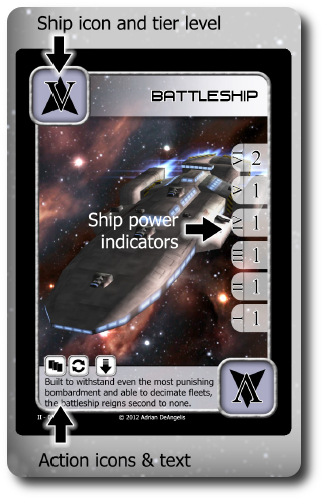
Once the squadrons have been assigned a target (players should feel free to move cards around to make it easy to see which ships are going to engage in combat), the opponents can protect their ships by raising their shields or by intercepting the player’s ship with ships in their hand that have not yet been played to the “combat zone”. Any player can attempt to intercept, however, making it an excellent idea for all players to be as friendly as possible with their opponents until they attempt to nuke them.
When an attacking squadron is intercepted, the same rules of engagement are observed. Thematically speaking, this battle is taking place while the attacking forces are in transit to their destination. If the engaging interception forces is more powerful, a battle does not ensue, oddly enough. Instead, the attacking player’s ships kick their engines into overdrive and flee back into the player’s hand, as do the cards used in the interception maneuver. Note that an interception force can be sent when a player attempts to withdraw a squadron during their tactical phase. If successfully intercepted, the squadron does not withdraw and is stuck in the “combat zone”.
After all shields are raised, intercepting forces are deployed, and attackers are repelled, any remaining attacking forces that are not stopped destroy their targets. Destroyed ships are placed in the discard pile and the player’s ships are returned to their original location in the “combat zone”.
Espionage, Warheads, and Doomsday Devices
Ships are not the only weapons available to a player. They can use their empire’s Espionage card to wage war with the enemy with dirty tactics and under the table dealings, but only against one player. While the spies of the galaxy battle with cloaks and daggers, a player can also build up an arsenal of warheads. Warheads are played to the player’s “tactical zone” where they are deployed and ready for use. The power of an individual warhead is quantified by the number of charges it has. All warheads start with 3 charges, but this can be expanded, making the warhead even more powerful. A single charge from a warhead will destroy any ship, regardless of its tier value. Two charges are powerful enough to destroy an entire deployed start fleet. Use of any warhead, however, comes with risk. Once a warhead is activated, all the charges that are used must target ships currently in the “combat zone”. The player first takes out their opponent ships. If the only ships left in the “combat zone” belong to the player and there are still charges left that are not accounted for, the player must destroy their own ships!

Along with the technology cards in the game that provide a player’s ships with passive bonuses and the upper hand in battle, a player can optionally play a Doomsday device. These are powerful cards that can change the balance of war in unpredictable ways. Of all the cards in the game, the Doomsday cards are the most difficult to use and the most chaotic. With one card, a player could win the entire game, eliminate all the players, or just themselves. As such, it is suggested in the rules that the Doomsday cards be removed when teaching the game to new or inexperience players. In other words, remove the Doomsday cards so they don’t shoot themselves in the foot.
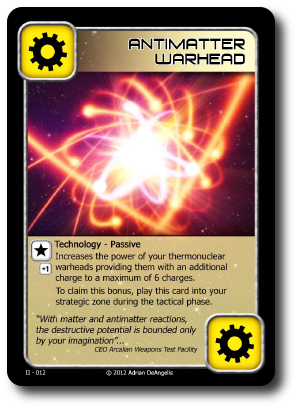
Note that each empire has a defined “forbidden technology” that they cannot use. Players who belong to that empire can never play any card that matches the technology that is forbidden, but can keep them in their hand as a means to bluff their opponents into thinking they are more powerful than they really are.
Diplomacy and Table Talk
Space Fleet Alpha is meant to be played socially, with all the players free to make and break alliances with other players or use their cards as bluffs to threaten those who might be edging a bit too close for comfort. Any and all deals can be brokered among the players, but they must be done at the table and in public. No private backroom dealings are permitted and cards can never exchange hands. It might also help players to remember that only one player can win this game. A trusted friend in battle that helps destroy the opposition will eventually become a target and aggressor.
Elimination and Victory
As the game continues, ships will be deployed and destroyed. A player is still in the game as long as they have at least 1 ship in the “combat zone”. If the player is ever unable to deploy a ship on their turn during the action phase leaving them with an empty “combat zone”, they are eliminated from the game, regardless of what cards they have in play or how many they have in their hand.
Victory is achieved when there is only one player left with ships in the “combat zone”. All of their opponents have been eliminated and the vastness of space and an infinite empire is now theirs to command! Of course, it is perfectly possible that all the remaining players are eliminated at once, leaving none alive to rule the empires. In which case, the game is considered a draw.
There is more to this game than what we have summarized above. To learn more about Space Fleet Alpha and read the full rules which contains excellent examples and more in-depth combat rules, visit the game’s web page at the publisher’s web site or on the Game Crafter.
Prediction
Space Fleet Alpha is a difficult game to predict from just the rules. While the rule book does an excellent job of introducing and summarizing the actions and icons used in game play, you don’t really get a good grasp of what this game is all about until you start to look through the cards. Once you do that, you begin to realize two very important things about this game. First, it isn’t particularly hard. There is a lot a player can do on their turn, but they are limited to only a small handful of actions. This makes player turns easy to manage. Second, the game has limited resources. There are cards that allow the player to target ships and remove them from the game, but at a cost of losing a ship of their own. Since all the cards in the game are a limited resource, destroying and using a card is not something that should be done lightly. There is only so much available to the players until their proverbial resource well runs dry. Hand, and to a certain extent, deck management is a must.
Teaching the game to the Child Geeks took about 20 minutes, which included game play examples and mock combat. The Doomsday devices were removed. Teaching the game to the Parent Geeks only took about 15 minutes with examples. The Gamer Geeks needed only about 5 minutes of game explanation before they felt they were ready to go. Any player who was already familiar with card games that had variable powers and actions were able to grasp the game a bit faster than those who were not.
And so, as I set up the game for a little space combat action with oldest little geek, I asked him his thoughts on Space Fleet Alpha so far before we blasted off into the stars.
“This game sounded complicated at first, but after you explained it, I think I can play it just fine. Bring it, Dad.” ~ Liam (age 8)
Well, well, well. Look who thinks they can pilot an intergalactic warship better than their old man! Let’s put this game to the test and see if it provides epic win or epic fail.
Final Word
This is not a game you can play just once and get a good feel for it. The card distribution is always random, which means you might have a lot of great cards in one game and only so-so cards in the next. We played the game several times with our Child Geeks, and each game was different. What was not different was the Child Geeks growing fascination with the game play. At first, they really didn’t know what to make of the game and it showed in their turns. They fumbled around with their cards, made some silly attacks, and more or less just sat back as they learned. As the game progressed and they became more familiar with how the game was played, they started to talk at the table more, make alliances, and even drop some major warheads on their opponent’s fleets! We never once introduced the Doomsday devices and this worked out just fine. There is more than enough going on in the game for the Child Geeks to handle. Reading is necessary to play, but Child Geeks as young as 8-years-old could play this game without too much assistance, doing very well throughout. As such, we can recommend the game to players as young as 8 and the Child Geeks fully approved it.
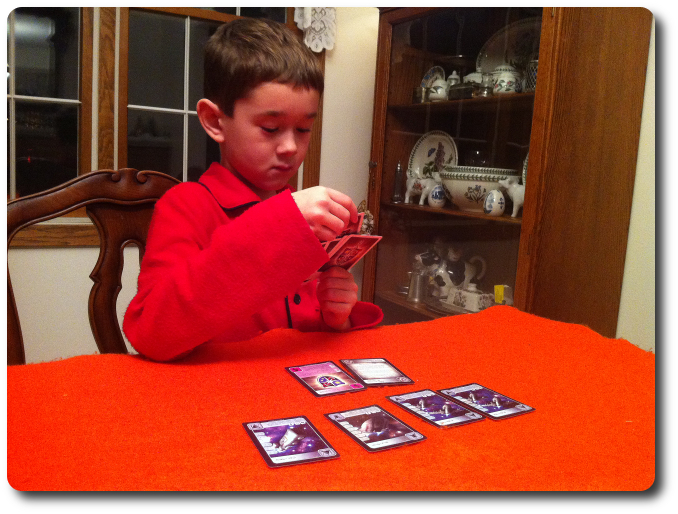
My little geek intergalactic warship admiral determines his next move
Parent Geeks, like the Child Geeks, didn’t know what to make of the game at first. The game introduces itself as nothing more than a bunch of cards. It was only after a few turns that the Parent Geeks started to really get into the game and rip each other apart. They found the game to be fast, but just slightly more involved than the typical casual games they usually played. The Parent Geeks who were gamers had no problems with the game, but the non-gamers most certainly had a steeper learning curve. In the end, the Parent Geeks decided to approve it, but not as a casual game. They really liked that the game could accommodate up to 6 players at once meaning everyone could sit at the gaming table and enjoy it. This lead them to believe Space Fleet Alpha was an excellent family game for gamers.
Gamer Geeks liked this game from the very start. They enjoyed the combat and the meta game played out at the table through alliances and threats. The only aspect of the game that slightly irritated them was the fact that a single player could cause everyone in the game to lose, in which case, the game was a draw. It happened twice and both times were epic. What the Gamer Geeks did enjoy was how fast the game was played, the tactics and strategy that had to be used to play the cards, and the diplomatic discussions at the table. The game felt big, but played fast like a smaller game. The Gamer Geeks thought Space Fleet Alpha was an excellent choice for starting the game night off and ending it…with a nova bang.
Space Fleet Alpha was a big surprise for me. When I first read it, I envisioned something very close to but a bit more complex than the card game, Mag Blast. Instead, the game felt like a tactical battle in space using miniatures as I engaged my opponents and held up my side of alliances with quick intercepts and nasty bits of espionage. The game felt deeper than expected and much, much more rewarding. The game gives the players a lot to think about, but only if the player really wants to put the time and energy into it. Space Fleet Alpha can be played casually with the player doing little other than occasionally engaging their opponents. The best way to play, however, is to be aggressive and engage the other players in diplomacy and tactical nukes! The combat in the game is stripped down and quick, but decidedly well thought out and meaningful. The Gamer Geeks took excellent calculated risks and the Child and Parent Geeks simple let their laser cannons fire without much thought. Both types of games were fun and always left me feeling satisfied, if not disappointed with a loss. I am eager to get it to the table again, and again, and again. Best of all, I can, because it takes very little time to set up and only about 30 minutes to complete.
My only negative comment about the game is the player elimination. We had a few games where players were unable to play any ship cards to their “combat zone” early on and were forced to watch 20 minutes of game play. This left them downright disappointed and bored. When this happened to the Child Geeks, they just left the table. The Parent Geeks quietly and politely waited, with the occasional loud sigh. When it happened to Gamer Geeks, they usually just got a beer and then made offhanded and somewhat passive aggressive comments until the game was over. In all cases, it felt like a waste of player power. The chair at the gaming table was being occupied (most of the time), but not used.
If you are looking for a card game that challenges the players to control space and defend their borders, while at the same time attacking and reducing their enemies to space dust, where diplomacy at the table is a necessary game component and means to victory, than do take a look at Space Fleet Alpha. An excellent card game well worth your time.
This game was given to Father Geek as a review copy. Father Geek was not paid, bribed, wined, dined, or threatened in vain hopes of influencing this review. Such is the statuesque and legendary integrity of Father Geek.



